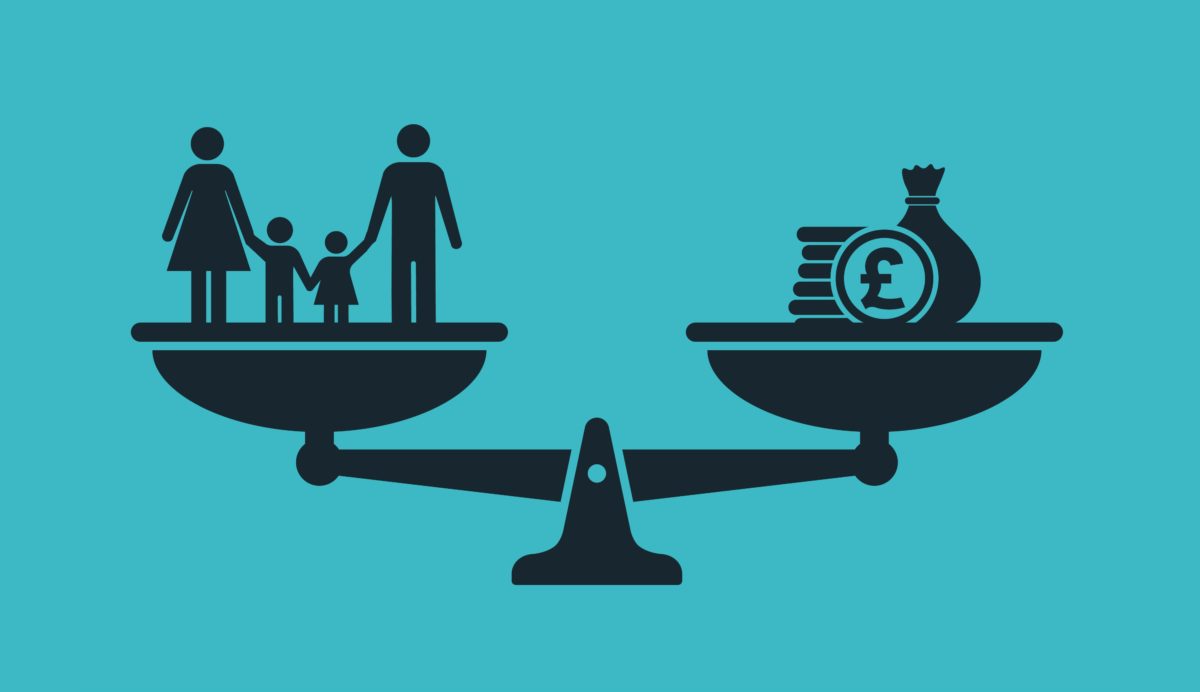Dr Rita Griffiths, IPR Research Fellow.
Universal Credit (UC) is replacing six means-tested benefits and tax credits with a single monthly payment per claimant or jointly claiming couple. The UK government describes it as the most significant reform to social security policy since the inception of the welfare state, and around seven million households, including half of all families with children, are expected to be claiming the benefit when it is fully rolled out. The changes will have huge impacts on women, particularly women with dependent children. Recent interest has focussed on the single monthly payment to couples and the risk it may pose to women’s financial independence and autonomy. Much less commentary addresses whether the policy will help or hinder women’s labour market entry and progression.
According to the architects of UC, additional claimants moving into work or earning more will do so as a result of three significant changes to the social security system. First are improvements to financial work incentives. Removing complex hours rules and ‘cliff edges’, a single taper reduces entitlement gradually as earnings rise. For families with children, a ‘work allowance’ also means that the first slice of earnings is ignored before the benefit starts to be reduced. Working parents are additionally entitled to a financial contribution of up to 85% towards childcare costs. Unlike tax credits there are no restrictions on the number of hours that must be worked, although in couple families, both parents do need to be in employment.
Second, a more intensive conditionality regime, underpinned by tougher sanctions, determines benefit eligibility. Conditionality has also been extended to new groups of claimants. For the first time, partners in jointly claiming couples with children, and some working claimants, will face mandatory work-related requirements. Third is improved simplicity via the single taper and a single monthly award paid into an individual or joint bank account. For claimants on PAYE, there is also automatic adjustment of the payment if earnings rise or fall within the month, removing the need to reapply for benefits. Each of these key design features is likely to have disproportionate impacts on women, more especially women with caring responsibilities for children, including lone parents and mothers living with a partner. Not only this, but the gendered effects appear to be largely regressive, raising concerns for women’s equality and financial independence.
But let’s be positive. The government would argue that by giving them access to their own earnings, possibly for the first time, the requirement for partners in couple families to look for work, backed-up with support from a work coach, could potentially increase the financial independence of some mothers who might otherwise have remained outside the labour market. Financial help towards childcare costs is also more generous. However, the UK has one of the highest levels of childcare costs in OECD countries. 15% could therefore represent a significant contribution to be found from net earnings. A cap on the amount parents can reclaim per month also limits the payment to £646 for one child and £1108 for 2 or more children. Given that UC claimants are typically among the lowest-paid workers, depending on where you live and the number of children needing child care, the financial gain from working could easily be wiped out. Childcare fees must also be paid up-front and reclaimed online, monthly in arrears, which could present added difficulties for some.
The better off calculation is starker still for couple families who have only one work allowance. Once the allowance has been used up by the main wage-earner, the benefit is reduced by 63 pence for every (net) pound of subsequent household earnings. The generosity of the allowance was also reduced in the last round of swingeing benefit cuts. Not much incentive to work for prospective second earners who face some of the lowest financial gains from employment under UC . And who are these second earners? The vast majority are women.
A plethora of academic and government-commissioned research has shown that a combination of high childcare costs and poor financial gains from employment are amongst the key reasons why many low-income mothers prefer to wait until their youngest child starts school before re-entering the labour market. For all its claims of ‘making work pay’, UC does little to tackle these structural barriers. The government’s response is that some second earners may choose to reduce or ‘rebalance’ their hours, or leave work altogether, allowing the family to achieve a better work-life balance. The message that mothers should leave the labour market to care for children is not only deeply contradictory in terms of UC’s overall policy thrust but, as many commentators have pointed out, harks back to a previous era of breadwinning men and stay-at-home mothers which bears little relation to the current world of work. The response is also disingenuous. Low wages and high housing costs mean that few families will be in a position to make this choice; in most low and modest-income couples, dual earning is an economic necessity. Moreover, if the government genuinely wanted partnered mothers to reduce rather than increase their hours of work, there would be no need for the further extension of an already onerous conditionality and sanctioning regime to them.
Which brings us to the next gendered aspect of Universal Credit; extended conditionality for families with children. Under the legacy benefit system, lone parents, the vast majority of whom are women, had already had their options to remain out of the labour market progressively curtailed. Under UC, the opportunity to remain at home to care for children has been restricted yet further. As soon as their youngest child turns one, lone parents are required to attend regular work focused interviews at a Jobcentre. With a youngest child aged two comes the requirement to take active steps to prepare for work and once the child is three, unless they or their child has a disability, lone parents are expected to spend 16 hours per week in paid work or looking for work. With a youngest child aged between five and twelve, the number of hours to be worked or spent job searching increases to 25 per week. Once the youngest child is settled into secondary school aged 13, the regulations make no concession to the parenting role. Lone parents must undertake paid work or demonstrate jobsearch equivalent to 35 hours per week. If there are no jobs available locally, like most other jobseekers, lone parents are expected to look for work further afield, potentially involving a commute of up to an hour and a half each way. Discretionary ‘easements’ around the number of hours parents must work are meant to take into account the local availability of childcare and of part-time employment, but those who fail to meet agreed work-related conditions without good cause could still incur a financial sanction.
Under UC, it’s no longer just lone parents who face a harsher set of work conditions. For the first time, couples with children are required to nominate a ‘lead carer’ who will be subject to a similar conditionality regime as lone parents. Again, the vast majority of those affected are women. The rules are complex, but conditionality is normally mandatory until the couple’s joint earnings reach an agreed minimum earnings threshold. Under the previous benefit and tax credit system, main carers in couple families were only required to attend work-focussed interviews. As Alison Garnham of the Child Poverty Action Group notes, obliging couples with children to nominate a ‘lead carer’ reinforces traditional gender roles and the gendered division of labour. Why is it not possible for both men and women with children to choose to restrict their working hours to care for children? This matters because more equal sharing of childcare responsibilities between men and women is central to reducing the gender pay gap. These new work-related responsibilities imposed on lead carers also confer few compensating rights. The joint claimants in a couple have no individual right to receive or access any part of the UC payment.
Which takes us onto the single monthly payment. Whether couples nominate a single or a joint bank account, this arrangement assumes that there is fairness and equity between women and men in the distribution and control of household income. Research studies indicate that, in many households, this is not necessarily the case. Other research shows how women with little or no access to income may be at greater risk of financial abuse and could be prevented from leaving a controlling or abusive partner. The Equality and Human Rights Commission (EHRC) found that the single household payment could represent “a drastic shift in income from women to men” and was therefore “worrying for gender equality.” The Scottish government agrees. Reflecting its new powers over some aspects of social security, a recent consultation on different payment options for UC revealed overwhelming support for automatic split payment to couples. In spite of lobbying by a range of different organisations, the UK government insists that the single monthly payment is integral to the design of UC. Splitting the benefit should therefore continue to be by exception, they say.
It may well be the case that under UC, some women with children will enter the labour market earlier than they might otherwise have done, for example those with a controlling partner who might formerly have stopped them from going out to work and earning their own money. But if getting more low-income mothers into sustainable, well-paid employment is a key policy goal of UC, is the system of financial incentives and onerous conditionality regime really the best way of achieving it? The implication is that many of these mothers do not want to work, so must be coerced or compelled under threat of sanctions. However, over four decades, the UK has seen an unstoppable rise in the proportion of women in employment. Maternal employment has seen the biggest rise of all. In 1975, only half of UK mothers of dependent children went out to work. By 2015, the proportion had reached 72%. As of 2017, 70% of lone mothers and 76% of partnered mothers were in paid employment and this percentage looks set to rise still further. Whether out of choice or economic necessity, dual earning in couples has become the norm.
Policymakers are therefore pushing at an open door. Indeed, the government’s own research shows that structural barriers to employment, including low pay rates and high childcare costs, in large part account for low maternal employment among the residual group of mothers remaining outside the labour market Cultural influences, including a distrust of paid child care among some parents, may also be important contributory factors. Rather than wielding a big stick, the same goal of increasing the proportion of low-income mothers in the workforce could therefore be achieved in other ways, for example by extending universal early education to children from the age of two and by expanding the current offer of 38 funded weeks to 52.
So, UC is regressive and has disproportionate impacts on women, many of which risk undermining their financial independence and autonomy, in addition to their well-being more generally. This is a message that the Women’s Budget Group, Child Poverty Action Group and Gingerbread, together with other women’s organisations and academics, have been trying to get across ever since the benefit was little more than a gleam in Iain Duncan Smith’s eye. But the messages are not being heard or, if they are, they are not being listened to. You will find precious little information about the gendered aspects of UC in any of the official documentation, research or reports produced by or on behalf of the government or Department for Work and Pensions. Nor will you hear about them in any official government statement or politician’s speech. The last Equality Impact Assessment for UC, published back in 2011, is condescending and disingenuous in its side-stepping of the issues. Its verdict? That UC is largely gender neural, affecting men and women in the same situation in roughly equal measure. Of course, they rarely are.
The government’s stance also flies in the face of mounting concern from across the political spectrum. Frank Field, Chair of the House of Commons Work and Pensions Select Committee, recently remarked, “This is not the 1950s, men and women work independently, pay taxes as individuals and should each have an independent income. Not only does UC’s single household payment bear no relation to the world of work, it is out of step with modern life and turns back the clock on decades of hard won equality for women.” Heidi Allen, Conservative MP and another key member of the Work and Pensions Committee, similarly commented, ““It can’t be right that payments are made by default as a single block to a household. In the 21st century women deserve to be treated as independent citizens, with their own aspirations, responsibilities and challenges.”
However, while suggested alternatives to the single household payment for couples would reduce the risk of ‘purse to wallet’ income transfers and of financial abuse, the wider potential for gender discrimination in the design of UC remains. Different elements of UC also send deeply contradictory messages. The policy emphasises individual responsibility and self-reliance, while at the same time potentially placing the entirety of the household income under the control of one individual and obliging one partner in a couple to be financially dependent on the other. A single household payment into a single account also does nothing to boost the financial capability and inclusion of the non-recipient partner. The lack or loss of access to household income by one of the partners could also have unintended consequences for family formation, for example an unwillingness to repartner or couples being forced to live apart.
So, what can be done? An updated equality impact assessment would be a good start; so too would increasing the work allowance for couples. The question also needs to be asked as to whether the design of UC is appropriate for couples who live together and families with children. Indeed, perhaps now is the time for a wider review of the family-based system of means-tested social security of which UC forms a part. When the vast majority of women now go out to work, and dual earning in couples is an economic necessity for most, it cannot be right that many means-tested benefits remain based on the assumption that one partner should be economically dependent on the other. If further inroads are to be made in terms of reducing gender inequality in the social security system and in the labour market more widely, tackling this fundamental contradiction will be key.





I’m a 54 year old woman with a 14 year old son, living with my partner (61) of 2 years. We went onto Universal Credits April last year when the company we both worked for ceased to trade. We have struggled for a year with the benefits and have got ourselves into debt trying to get off this god forsaken benefit. There is a lot of pressure and threats to find work but little money to live on. My partner recently found employment some distance from home. He commutes daily of 3 hours (return) and his petrol bill is £500 a month. Recently we had to MOT and service our old car (£1200) which we couldn’t afford so set up a direct debit so he had the car for work. Because of the amount he earns £1980 per month all UC payments have stopped but we have to pay out £750 a month so he can go to work. My child tax credits have ceased and I now only get £84 per month child benefit to raise my son. My partner is expected to cover all our costs and his own on £1250 a month. That’s rent, utilities, food, school transport, council tax etc. I feel really uncomfortable about this, my son is not his responsibility and I feel a strain on the relationship. I feel beholden and trapped by this situation and it is affecting me mentally. I had been a carer for my mother who has recently passed away and had to deal with her funeral and estate whilst dealing with my partners new job, Universal Credits pressure, a new school for my son and a house move, whilst seeking employment for myself. I watch my son looking at us with worry whilst missing out on a childhood and living in poverty, it’s heart breaking. What an existence........it’s appalling. Whilst all the time people are berated for being scrougers and low life for being on benefits. I give up!
From: julia whatley
Sent: 21 January 2020 09:50
To: julia whatley
Subject: U. He'll.
Universally
I am stuck
Confined to drudgery
Toil and I do begrudge
Pension age and yet
As long as you slave
Apparently not enough
A sanction you say
Unless I obey
Rent arrears
Leads to eviction
When I fall behind
Inevitable as not
Cannot claim rent
On nil Income
The time has come
To follow my head
I will find a way
My plans on hold
Do as you are told
One more year plus
A waste of my body and soul
I be out there If I could
Living free to work
Applying the skills
This systems forgotten
Sucking the Life out of me
The nightmare of uniformity
In the process
Destroying our planet
On the never ending quest
For money
That will not set us free
Sent from my Samsung Galaxy smartphone.
I’d like someone to address another gender discriminate issue in universal credit. There appears to be a growing trend of fathers “claiming to have all kinds of conditions” and the their job centre taking them off job hunting, essentially meaning that their child support per month remains a mere £28 per month indefinitely while the single mother is being threatened to find work. Now is it correct that the sole financial responsibility and care responsibility should be placed on the woman alone? Why are the job centres signing single fathers off from looking for work? I’ve met with many single mothers claiming this and I personally think that UC should be sued. We are being punished because essentially “we have the womb, we chose not to take pills that poison our bodies so that men can treat us like a plaything, we chose not to murder a child and so it all falls on us.....NO MORE, it’s time to for everyone to STOP talking and writing about it and act